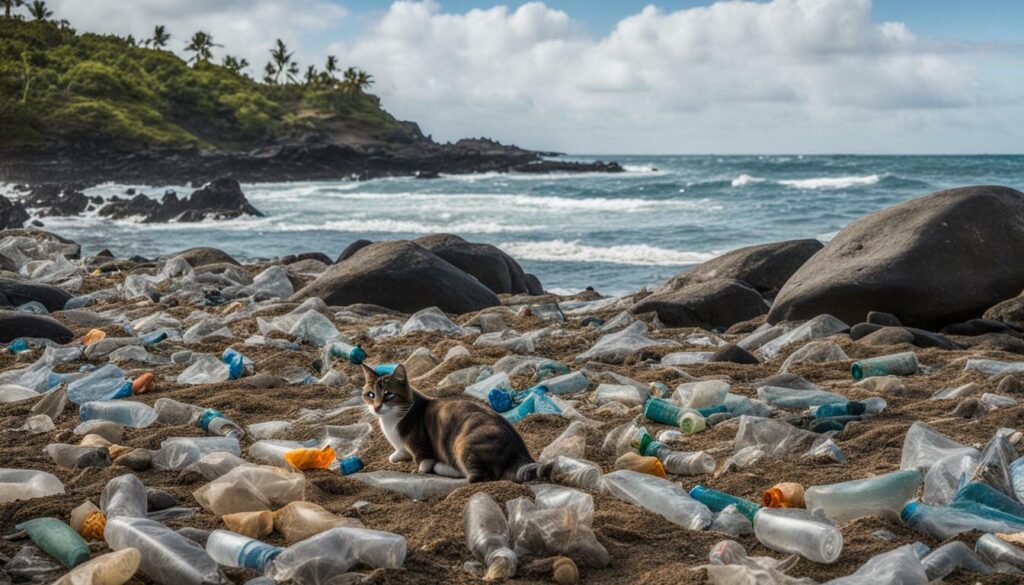Table of Contents
Stray cats are a common sight in many urban areas worldwide, and their impact on the environment can be significant. While their presence can have some benefits, such as controlling rodent populations, stray cats can also cause harm to the marine ecosystem.
Stray cats that live near the coast can contribute to ocean pollution through their waste, which can contaminate water bodies and threaten marine life. Additionally, these cats can disrupt the balance of the marine ecosystem and pose a threat to vulnerable species, ultimately impacting marine biodiversity.
In this article, we will delve into the impact of stray cats on marine life, discussing their role in ocean pollution, their effect on the marine food web, and the threat they pose to marine biodiversity. We will also explore the importance of including stray cat management in marine conservation efforts, as well as the role of human intervention in controlling their population.
Key Takeaways
- Stray cats can contribute to ocean pollution and threaten the marine ecosystem.
- Their impact on the marine food web can disrupt the balance of the ecosystem and threaten vulnerable species.
- The management of stray cat populations is crucial in marine conservation efforts.
The Role of Stray Cats in Ocean Pollution
While stray cats may seem like a harmless presence in our communities, they can indirectly contribute to ocean pollution. One of the primary ways they do this is through their waste.
Stray cats often defecate and urinate in public areas where their waste can be washed into storm drains and eventually make its way into water bodies. Their waste contains harmful bacteria and parasites that can contaminate the water and harm marine life.
In addition, stray cats that scavenge for food in trash cans can also contribute to ocean pollution. When they knock over trash cans or rummage through garbage, they can spread litter and debris that can end up in waterways and affect marine habitats.
Efforts to mitigate the impact of stray cats on ocean pollution can include responsible pet ownership and trap-neuter-return programs that help to control the stray cat population. Educating the public on the importance of properly disposing of household waste and not feeding stray cats can also help to reduce their contribution to ocean pollution.
Stray Cats and the Balance of the Marine Ecosystem
Stray cats can have a significant impact on the marine ecosystem and disrupt its delicate balance. As a top predator, stray cats can affect the food web and contribute to the decline of certain marine species.
When feral cats hunt and kill small mammals, they can indirectly affect the marine food web by reducing the prey population of larger marine predators. For example, if a feral cat kills a bird, that bird may have been a food source for a larger predatory bird. This can cause a ripple effect that eventually affects the entire food web.
In addition to their impact on the food web, the presence of stray cats can also lead to increased stress on certain marine species, such as sea turtles and shorebirds, who may abandon their nests or feeding areas due to the presence of cats. This can have serious consequences for the survival of these species, many of which are already threatened or endangered.
To maintain the balance of the marine ecosystem, it is important to manage the population of stray cats and prevent them from predating on vulnerable marine species.
The Threat of Stray Cats to Marine Biodiversity
Stray cats pose a serious threat to marine biodiversity. These feral felines are known to prey on vulnerable marine species, including birds, reptiles, and small mammals. Their predation can disrupt the balance of the marine ecosystem and threaten the survival of certain species.
The impact of stray cats on marine biodiversity is further exacerbated by their population size. According to estimates, there are millions of unowned cats in the United States alone, many of which are feral and have no regular source of food. The resulting competition for resources can lead to increased predation and negative effects on marine biodiversity.
To address this issue, marine wildlife conservation efforts must collaborate with animal welfare organizations to manage the population of stray cats. One effective approach is trap-neuter-return programs, which involve trapping feral cats, sterilizing them, and then returning them to their original location. This approach reduces the population of feral cats over time without resorting to euthanasia.
Another possible solution is responsible pet ownership. Encouraging individuals to spay or neuter their pets can help reduce the number of cats that end up on the streets. Additionally, encouraging individuals to keep their cats indoors can prevent outdoor cats from contributing to the problem.
Ultimately, managing the stray cat population is critical to protecting marine biodiversity and ensuring the long-term health of the marine ecosystem. By implementing effective management strategies, we can create a more sustainable future for both cats and marine wildlife.
Stray Cats and Marine Conservation Efforts
When it comes to marine conservation, stray cats might not be the first thing that comes to mind. However, these feral felines can have a significant impact on the health and balance of marine ecosystems, making it imperative to include them in conservation efforts.
The issue of stray cats and their impact on marine life requires collaboration between animal welfare organizations and marine conservation groups. Without such cooperation, it’s impossible to implement effective measures to manage the stray cat population and reduce their negative impact on marine ecosystems.
One approach to dealing with stray cats is through trap-neuter-return (TNR) programs. These programs capture feral cats, sterilize them, and then release them back to their colonies. This method helps control the stray cat population and can reduce the number of cats preying on vulnerable marine species.
Responsible pet ownership is another crucial factor in managing the stray cat population. Pet owners should ensure their cats are spayed or neutered and kept indoors to prevent them from contributing to the feral cat population. Educating the public about the impact of stray cats on marine life is also necessary.
Community involvement is essential in tackling the problem of stray cats and their impact on marine conservation. Local initiatives, such as setting up feeding stations and providing shelter for cats, can help reduce the number of stray cats by providing them with safe, stable environments. These efforts can also help increase awareness of the consequences of stray cats on marine ecosystems.
By working together and implementing proactive measures to manage the stray cat population, it’s possible to reduce their negative impact on marine life and protect the health and balance of marine ecosystems for the benefit of generations to come.
Understanding the Impact of Feral Cats on Marine Life
Based on the previous sections, it is clear that feral cats have a significant impact on marine life. The stray cat population is a growing concern, and the connection between these cats and the marine ecosystem cannot be ignored.
Stray cats contribute to ocean pollution through their waste, which can contaminate water bodies and harm marine life. They also disrupt the balance of the marine ecosystem and threaten the biodiversity of vulnerable species through predation.
It is crucial to address this issue and implement proactive measures to manage the stray cat population effectively. Collaboration between animal welfare organizations and marine conservation groups is necessary to mitigate the impact of feral cats on marine life.
Overall, the impact of stray cats on marine life underscores the importance of responsible pet ownership and community involvement in controlling the population of feral cats. It is vital to protect the marine ecosystem from further harm, as it is essential for the sustainability of our planet.
The Role of Human Intervention in Stray Cat Control
Controlling the population of stray cats is crucial for maintaining the ecological balance of the marine ecosystem. Human intervention plays a vital role in achieving this goal.
One of the most effective ways to control the stray cat population is by promoting responsible pet ownership. Encouraging people to spay or neuter their pets can prevent unplanned litters and reduce the number of cats that end up on the streets.
Trap-neuter-return programs have also proven to be successful in managing the population of feral cats. These programs involve trapping feral cats, spaying or neutering them, and returning them to their original location. This approach helps to limit the number of new cats born on the streets while keeping the existing population under control.
Community involvement is also essential in controlling the stray cat population. Residents can work with local animal welfare organizations and government agencies to identify areas with high cat populations and develop targeted strategies for managing them. Education campaigns can also raise awareness of the impact of stray cats on marine conservation and highlight the importance of responsible pet ownership.
It is important to note that effective cat control efforts should prioritize the well-being of the animals themselves. While reducing the number of stray cats is necessary to protect marine life, it is also crucial to provide safe and humane treatment for these animals.
By taking proactive measures to manage the stray cat population, humans can help protect the marine ecosystem and the wildlife that depends on it. Collaboration between animal welfare organizations and marine conservation groups is vital in achieving this goal.
Conclusion
Stray cats have a significant impact on marine life and the fragile balance of the marine ecosystem. Through their indirect role in ocean pollution and their direct threat to marine biodiversity, their influence can be detrimental to the survival of various marine species.
It is crucial to address this issue proactively through responsible pet ownership, trap-neuter-return programs, and community involvement. Collaboration between animal welfare organizations, marine conservation groups, and government agencies is essential in managing the stray cat population and protecting the marine ecosystem.
Protecting the Future of Marine Life
The urgency of finding a solution to the impact of stray cats on marine life cannot be overstated. The well-being of the marine ecosystem is critical to the survival of the planet, and every effort must be made to protect it.
With a better understanding of the role of stray cats in ocean pollution, their impact on the balance of the marine ecosystem, and their threat to marine biodiversity, we can take informed steps towards addressing this issue. By emphasizing responsible pet ownership, implementing effective management programs, and encouraging community involvement, we can safeguard the future of marine life for generations to come.



